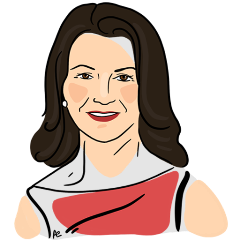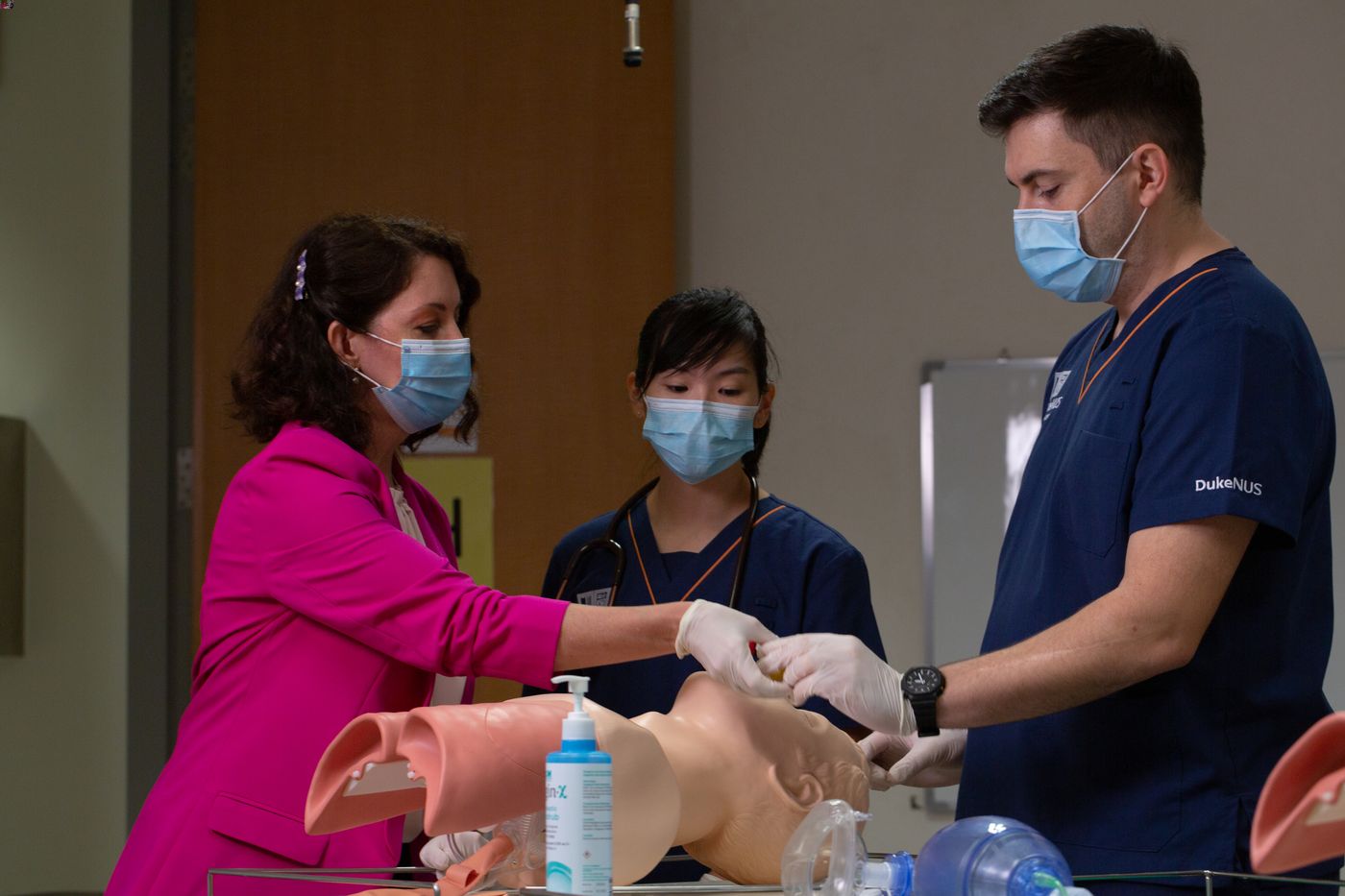 An educator adapts to restrictions and being in a new job while alone in a new country.
An educator adapts to restrictions and being in a new job while alone in a new country.
“So, I started on the tenth of February 2020 and Singapore had just gone into DORSCON Orange,” remembers Ms Kirsty Freeman about the first day of her new job in a new country; a country that had just raised its national disease alert level,
the Disease Outbreak Response System Condition or DORSCON, to its second highest level — orange. “I didn’t know what that meant. But I came to work, and there was this bustle — this unusual sort of vibe.”
Freeman discovered why later that day. The School had just had to withdraw every single medical student from the clinical environment. It was a necessary precaution. SARS-CoV-2 had spread to Singapore and the hospitals were on high alert: would this
be a replay of the 2003 SARS outbreak? This measure, however, meant no more opportunities for students to take an active role in a real clinical context. Further, clinical supervisors could not judge if these students had mastered the required
clinical skills.
As the incoming lead for the Clinical Performance Centre at Duke-NUS, Freeman
had been hired to make sure students could take medical theory out of the books and put it into practice. There would be gaps in learning opportunities now, she knew, with these students removed from healthcare institutions.
Freeman’s plans to watch and learn “for probably the first six months” to get “a feel for how the School does things” were out of the window. “The School has a really great history, so you don’t want to
come in and force change upon people when you don’t understand how things have come about,” she says.
“But on that first day, I realised my next six months were going to be a little different from what I’d thought.”
Shifting goalposts for simulation classes
Singapore’s DORSCON framework has four colour-coded levels: green, yellow, orange and red. They represent, in that order, the increasing severity of an infectious event in Singapore as well as the steps needed to contain it.
DORSCON Orange meant that the disease was severe and spreading easily among people, but also that it was being contained. Such containment would come with moderate disruptions to daily life, including temperature screenings and quarantines. Additional
sector-specific precautions — learnt from the previous SARS outbreak and the H1N1 pandemic in 2009 — were also rolled out, including cohorting of healthcare professionals and visitor restrictions in hospitals. Gatherings of students,
too, should be capped at 50 per group.
Any solutions that Freeman and the education team developed over the coming months would need to be in line with these measures.
Freeman, a fellow of the US Society for Simulation in Healthcare, would have to draw deep on her nearly 20 years of experience in delivering simulation-based education, assessment
and research as the pandemic evolved.
But finding ways to simulate clinical environments is Freeman’s area of expertise and passion. “I love simulation as a tool to take theory out of the books and put it into practice,” she shares.
Planning for replacement lessons to enable students to acquire the necessary skills to pass
the year would be further complicated by the rapidly changing situation on the ground.

KIRSTY FREEMAN WORKS WITH STUDENTS THROUGH A SIMULATED PROCEDURE
“Each week the goalposts were changing. You were never on solid ground,” says Freeman. “We would come up with a great plan but then a couple of days later — guess what? We couldn’t do that anymore because now everyone
must be so many metres apart. Or must now have masks and face shields on.”
She shrugs — this was the way things were, and we got on with it.
And so, while the constantly evolving measures were necessary, the educators and examiners would be put to the test.
“It was a new directive almost every other day — each a highly sensible new precaution — but each drove a big red bus through our curriculum plans,” Professor Ian Curran, Vice-Dean for Education, chuckles, remembering those early months. “We had to flex and adapt constantly. Often with just a few hours’ notice. You’re
told, mid-afternoon on a Sunday, that you couldn’t rotate your students on Monday.”
“These constant challenges demonstrated the true professionalism, creativity and adaptiveness of our educators as well as the resilience, grit and determination of our students. All characteristics that would stand us and them in good
stead as we navigated the challenging years ahead, as we adapted to the new normal,” says Curran, who like Freeman is a fellow of the US Society for Simulation in Healthcare.
The Clinical Performance Centre would also work closely with healthcare organisations and the Ministries of Health and Education in order to obtain critical equipment and resources such as personal protective equipment (PPE) and hand sanitisers
so that students could continue learning even if that learning had to be brought back to the School’s campus.
Clinics and wards would be swapped for replicas on the fourth level of the Khoo Teck Puat Building, where students would be trained using high-fidelity, life-sized manikins in life-like environments, working under the same pressures a clinical
team might face.
“Simulation ensures that when students have the privilege of interacting with real patients, they are prepared and ready to deliver really great care,” Freeman says.
To maximise training opportunities for students while making sure that group sizes remained within the permitted limits, her team ran simulations on weekends and late into the night.
“I was so proud of all our staff,” she says. “We completely re-envisaged our work life to meet the needs of our students.”
And for those times when in-person would just become impossible, Freeman and the team would create fully online learning opportunities.
“I loved our can-do attitude,” she shares. “Everyone rallied together and said, ‘Who’s got ideas? We don’t know how that’s going to work, but let’s do it!’”
Because right from the start, the School was clear that despite all the restrictions, in just a month’s time, the students would sit their high-stakes clinical exams.
“We felt it was important to validate our students’ own sense of knowing that they’ve made the grade and met the standard,” says Curran of Duke-NUS’ decision to hold these exams. “We also needed to demonstrate
to our clinical stakeholders and partners that our students were good to graduate and fit to go into practice.”
“Planes will fly again”
But what of Freeman’s own needs? The plan had been for her and her loved ones to fly between Australia and Singapore for regular visits. Her husband, too, would fly in from Perth around the middle of the year. Then, they would build
their life in Singapore together.
“That didn’t happen,” states Freeman. “I remember sharing with him — it was changing on a weekly basis — this great plan. A couple of days later, that’s up.”
Border restrictions would soon cancel all travel and ground planes. Freeman’s husband would remain in Australia until an unknowable someday.
Looking back, the busyness of work and the creative delight of pottery classes helped, says Freeman. The new bonds forged online — through Zoom catch-ups and spontaneous notes of reassurance — with others in the medical simulation
community sparked joy and provided much-needed encouragement and inspiration, too. And she never failed to have a virtual cup of tea with her husband every single day.
“We set our alarms early. Before our working day,” she shares. “Starting at six o’clock every morning, we’d meet each other on video and have breakfast together.”
They would check in on each other during these virtual sessions, asking about their friends and families. It would become the way they maintained their relationship for a long time, also because constant interactions in relationships is part
of Freeman’s larger approach to life.
“There’re so many people within Duke-NUS and our larger community here in Singapore who have been more isolated due to the pandemic,” says Freeman. “And we should be just reaching out to each other every now and then
to say ‘Hey, guess what? Thinking of you today.’”
Despite the many scuppered plans and constant need to respond and adapt Freeman has no regrets.
“You know what gets me through?” asks Freeman. “I have a job where I feel like I’m making a difference. I’m surrounded by like-minded people who are passionate about medical education and providing access to great
healthcare.”
“All that keeps me going. And hopefully, at some point in the future, planes will fly again.”